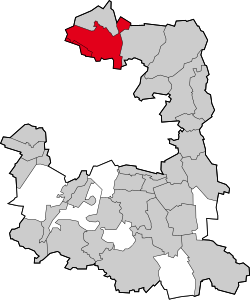Oberschleissheim
| Oberschleißheim | ||
|---|---|---|

Regatta stand
|
||
|
||
| Coordinates: 48°15′N 11°34′E / 48.250°N 11.567°ECoordinates: 48°15′N 11°34′E / 48.250°N 11.567°E | ||
| Country | Germany | |
| State | Bavaria | |
| Admin. region | Oberbayern | |
| District | Munich | |
| Government | ||
| • Mayor | Christian Kuchlbauer (FW) | |
| Area | ||
| • Total | 30.60 km2 (11.81 sq mi) | |
| Elevation | 483 m (1,585 ft) | |
| Population (2015-12-31) | ||
| • Total | 11,596 | |
| • Density | 380/km2 (980/sq mi) | |
| Time zone | CET/CEST (UTC+1/+2) | |
| Postal codes | 85764 | |
| Dialling codes | 089 | |
| Vehicle registration | M | |
| Website | www.oberschleissheim.de | |
Oberschleißheim is a municipality in the district of Munich, in Bavaria, Germany. It is located 13 km north of Munich (centre). As of 2005 it had a population of 11,467.
Oberschleißheim is best known for the Schleissheim Palace and the Flugwerft Schleissheim next to the airport housing the airplane department of the German Museum. The airfield is also home to one of the five German Federal Police helicopter squadrons.
During World War II, a subcamp of Dachau concentration camp was located here.
In the early 20th century, Schleißheim was home to author Waldemar Bonsels, who was inspired to write his "Biene Maja" by a gnarly tree in the woods nearby.
Schleißheim was first mentioned as “Sliusheim” in 785. In the Year 1315 the name of the village became “ Sleizheim”. Between 1616 and 1623 Duke Maximilan I. erected the Old Schloss. From 1701 to 1726 the New Schloss was built to the orders of Maximilian II Emanuel, including the Schloss Lustheim.
In the Mid 19th Century Oberschleißheim built a railway station with the name “Schleißheim” connecting to the Munich-Landshut railway route. This railway station was replaced by the “Oberschleißheim” station in 1972 due to the opening of the S-Bahn.
Starting in 1912, Oberschleissheim housed the first royal Bavarian airfield, which after World War I was used for civilian aviation and re-militarized in 1933. During the Third Reich, a satellite camp of the Dachau concentration camp was set up on the airfield. After World War II, first the United States Air Forces in Europe used the airfield (under the designation Airfield R.75), transferring it to the US Army in 1947 and abandoned in 1981. Today it serves as a civilian airfield as well as the base for the German Federal Police helicopter division.
...
Wikipedia



